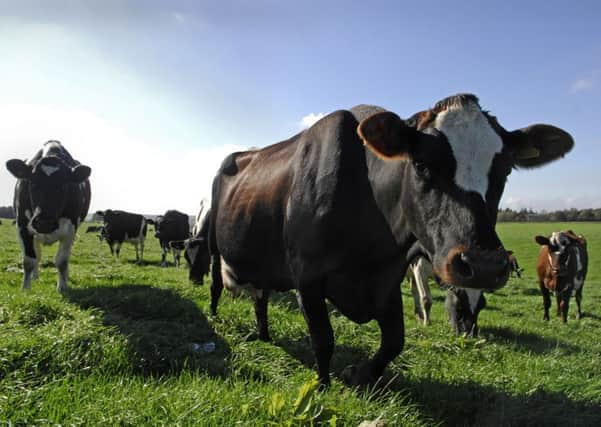Gulf opens up between best and worst paid farms


The catastrophic drop in milk prices over recent months has hit producers hard, the Kingshay group said, with a “massive” gap having opened up between the worst hit and a fortunate few who have seen little change at all.
Comparing March 2015 with the same month last year, 70 per cent of producers have seen a price drop of more than a six pence per litre (ppl) with some as high as 15ppl, while some producers have been shielded from the volatility altogether, with the top 10 per cent of herds ranked by milk price thought to be on ‘cost-of-production-plus’ contracts.
Advertisement
Hide AdAdvertisement
Hide AdAccording to the National Farmers’ Union, Tesco, Sainsbury’s, M&S and Waitrose offer a cost of production plus model, while Booths pays the highest milk price of any major retailer.
Richard Findlay, the NFU’s regional livestock board chairman, said the position of dairy farmers remained desperate.
“Dairy farmers used to get out of trouble by producing more milk, but when you are producing several thousand litres of milk below the cost of production, you start losing tens of thousands of pounds on the milk you produce.
“It leaves the industry in a very unsafe position. It’s on a knife edge. It’s not even a difficult decision for some farmers to give up milking now, they are either being told to by the banks or are choosing so themselves.”
Advertisement
Hide AdAdvertisement
Hide AdMr Findlay believes farmers are effectively punished for cutting their costs, instead of being rewarded.
“We are encouraged to become more efficient but all that means is you get paid less as an industry If we look at the bigger picture with supermarkets and buyers - it’s the same for beef and lamb. We use genetics to produce more efficient animals, make better silage and become more efficient and supermarkets offer help to do so. We follow that advice but we are rewarded by getting less. Farmers have never had a smaller percentage of the retail price.”
Mike King, vice-chairman of the Royal Association of British Dairy Farmers, said: “£1 billion has been wiped off dairy farming in the last 12 months and trends are now indicating that dairy farming is no longer viable for some of the most efficient producers, some of whom have suffered the highest price drops, and who are subsequently leaving the industry.
“Taking a long-term strategic view, we believe there are several measures which should be adopted starting with the major retailers who do not have aligned contracts of any description.
Advertisement
Hide AdAdvertisement
Hide Ad“We believe the major retailers can afford to a pay all farmers a fair price for milk. They have both discounted and devalued milk – a nutritional product, for far too long and appear to have every intention to continue to do so when in fact last week’s Mintel report found that consumers would actually be prepared to pay more for milk.”
The report found that on average consumers would be prepared to pay £1.28 for a four-pint bottle of milk, which currently retails at 89p-£1.
True grasp of costs is essential
According to Kingshay, the gap between the best and worst farm gate milk prices was widened from 5.6ppl in March 2014 to 11.6ppl in March 2015.
The average UK farm gate price in April was 24.59 ppl, according to the most recent data from DairyCo, down from 33.29ppl in April 2014.
Advertisement
Hide AdAdvertisement
Hide AdDuncan Forbes, Kingshay’s managing director, said: “Look very carefully at who you are selling your milk to. With margins so tight you must measure what your total costs of production are and work out a budget so you know what your businesses is going to look like further down the line.”